24 Brilliant Small Pantry Organization Ideas to Maximize Every Inch
Struggling to keep your tiny pantry tidy and functional? You’re not alone. Many homes face the challenge of limited storage space, especially in kitchens where every shelf and drawer matters. But a small pantry doesn’t have to mean constant chaos. With the right organization strategies, even the most compact space can become a powerhouse of efficiency.
Whether you’re working with a single cabinet, a narrow closet, or a few shelves tucked in the corner, the key is to think creatively and strategically. From clever container systems to space-saving tools, small pantry organization is all about making the most of vertical space, grouping like items, and using every nook to your advantage.
In this article, we’ll explore 24 small pantry organization ideas that are both practical and visually pleasing. These tips will help you streamline your food storage, minimize clutter, and create a pantry that works just as hard as you do. Ready to transform your space? Upload your images and let’s build this article together—one brilliant idea at a time.
1. Use Clear Containers for a Clean, Uniform Look
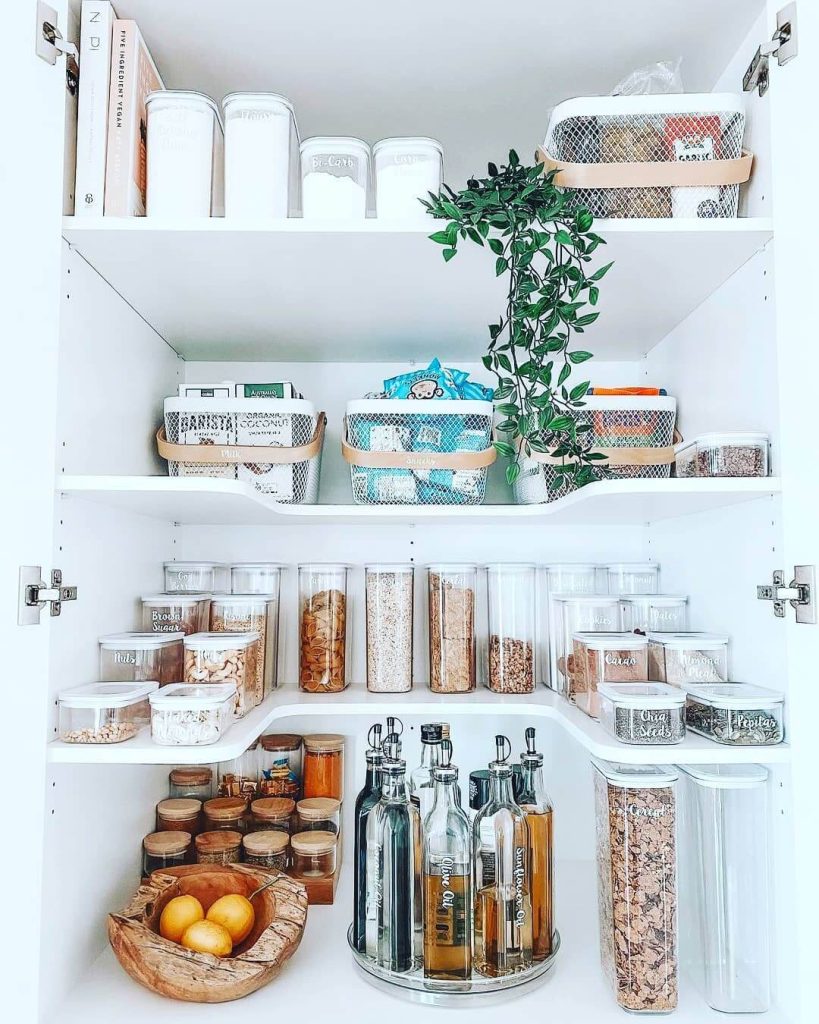
One of the most effective ways to organize a small pantry is by using clear, labeled containers for everything from dry goods to snacks. The first image showcases this beautifully with a visually stunning setup featuring airtight jars, labeled bins, and even a lazy Susan for oils. By transferring pantry staples into transparent containers, you not only gain visibility over your inventory but also maintain consistency and style. Labels make everything easier to find, and grouping items by type reduces visual clutter. This method transforms even a single cabinet into an efficient and elegant storage solution.
2. Group Dry Goods by Type for Instant Accessibility

The second image highlights a small pantry organized by food categories using uniform containers with bamboo lids. This method of categorizing lentils, flours, pasta, and snacks ensures quick access and simplifies meal prep. Shelves are utilized from top to bottom, and the smallest jars are smartly arranged to maximize every inch of vertical space. By sorting similar items together, you not only streamline cooking tasks but also make grocery planning a breeze. Plus, the uniform containers give the pantry a cohesive, high-end look while keeping everything fresh and accessible.
3. Maximize Wall Space with Floating Shelf Storage

Don’t have a pantry closet? No problem. The third image proves that open wall space can become prime real estate for pantry storage. Using floating shelves, this setup turns large glass jars into both storage and decor. Grains, legumes, and baking ingredients are kept in matching jars, providing both function and a rustic farmhouse feel. This approach is perfect for small kitchens lacking cabinet space. Pairing form with function, it transforms bare walls into an organized, Pinterest-worthy pantry system.
4. Label Everything and Use Wicker Bins for Hidden Storage
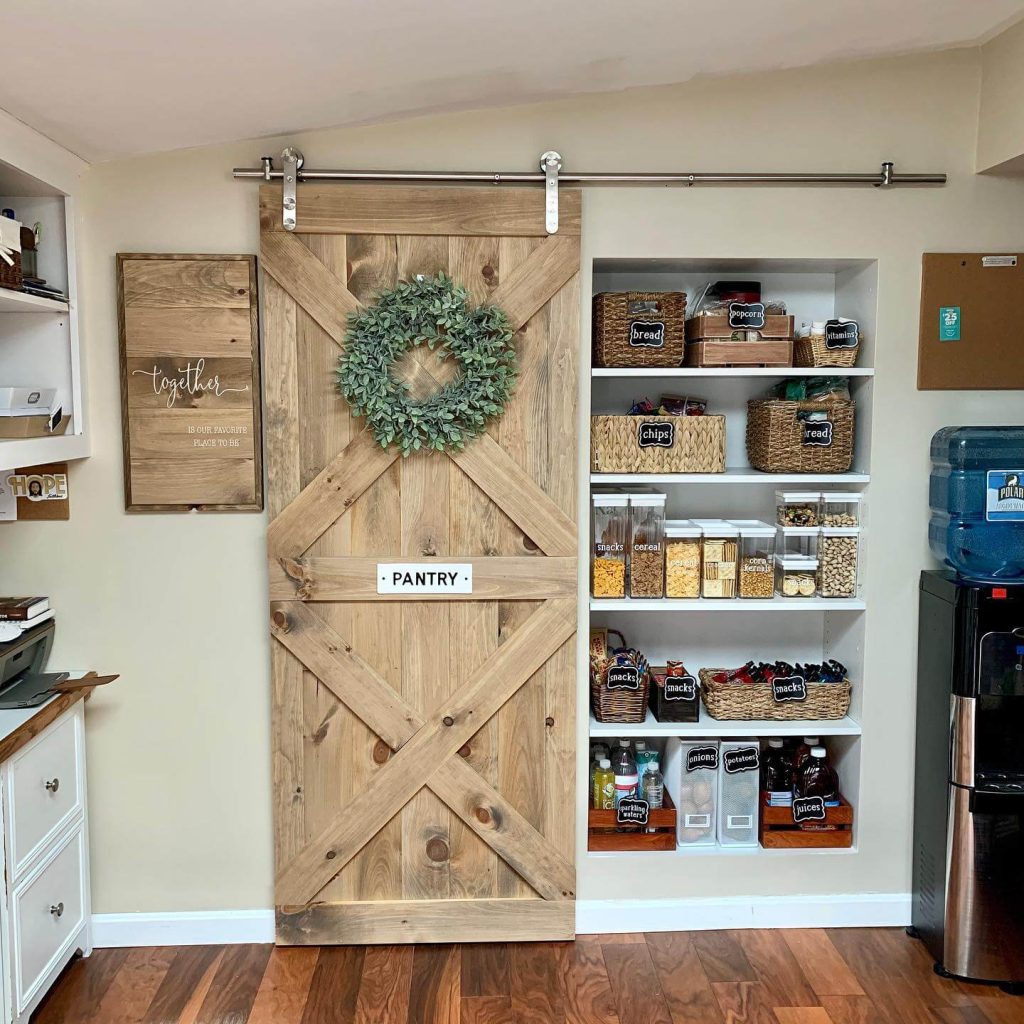
Charming and highly functional, the fourth image shows how using labeled wicker bins and stackable containers creates a clutter-free pantry with personality. A sliding barn door hides the pantry from view, but inside it’s a model of smart organization. By using bins labeled for snacks, chips, bread, and more, you create zones that keep everything in its place. The consistency in labels and baskets reduces decision fatigue and gives even small pantries a boutique grocery feel.
5. Combine Aesthetics and Function with Multi-Sized Containers

In the final image, the pantry is packed with a variety of jar sizes that fit snugly on each shelf. From tall glass pasta containers to small spice jars with cork tops, every item has its place. Even eggs and marshmallows have a designated home in this compact setup. The use of labeled wire baskets for produce like potatoes and fruit keeps airflow going, which is great for freshness. It’s a prime example of how mixing functionality with minimalist design can make even a small cabinet feel spacious and curated.
6. Create a Hidden Breakfast or Beverage Station
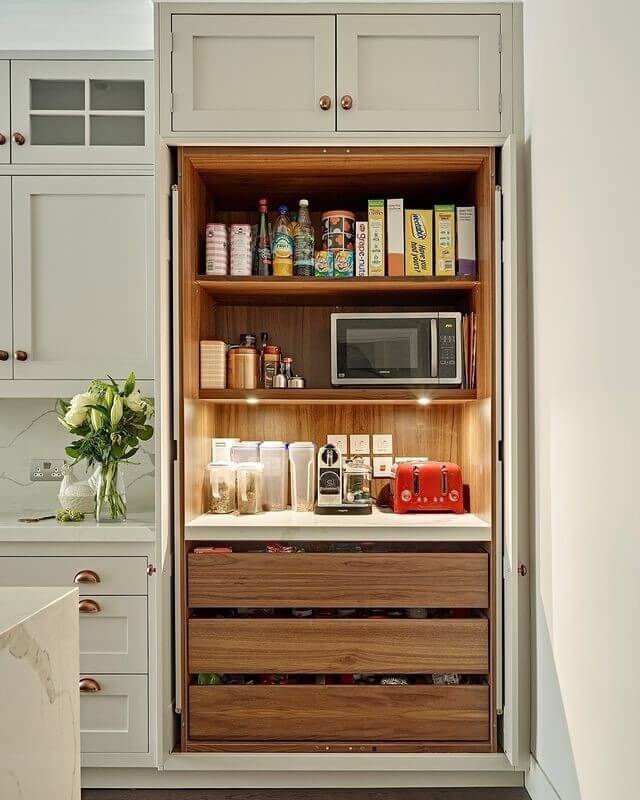
This clever cabinet setup features a compact pantry zone with pull-out drawers, a microwave, and countertop appliances—all hidden behind sleek doors. It’s perfect for creating a breakfast or beverage station within a small kitchen. The drawers store snacks and breakfast items, while the countertop holds a coffee machine, toaster, and cereal containers. Built-in lighting enhances visibility and functionality. This setup maximizes vertical space while keeping clutter out of sight, making it ideal for multipurpose households or anyone wanting a discreet, streamlined pantry solution.
7. Optimize Deep Shelves with Stackable Containers
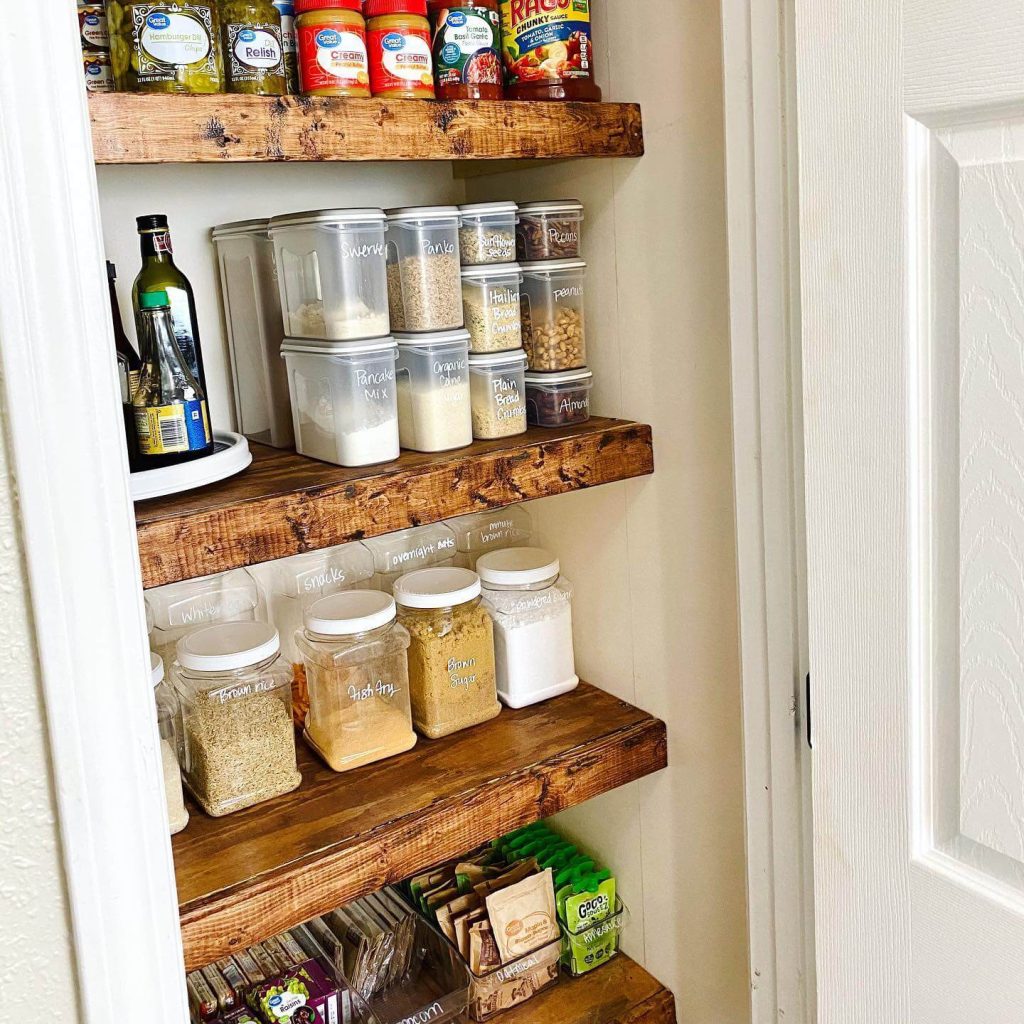
In this image, deep, rustic wooden shelves are transformed into efficient pantry zones with the help of stackable plastic containers. The labeled bins for pancake mix, flour, grains, and nuts allow for both vertical and horizontal organization. By stacking uniformly-sized containers, you avoid wasted headspace and can easily rotate stock. This setup is ideal for small or awkward pantry closets where shelf depth is a challenge. The natural wood adds warmth and charm, while the containers keep everything easily accessible.
8. Zone Your Pantry with Baskets and Bins
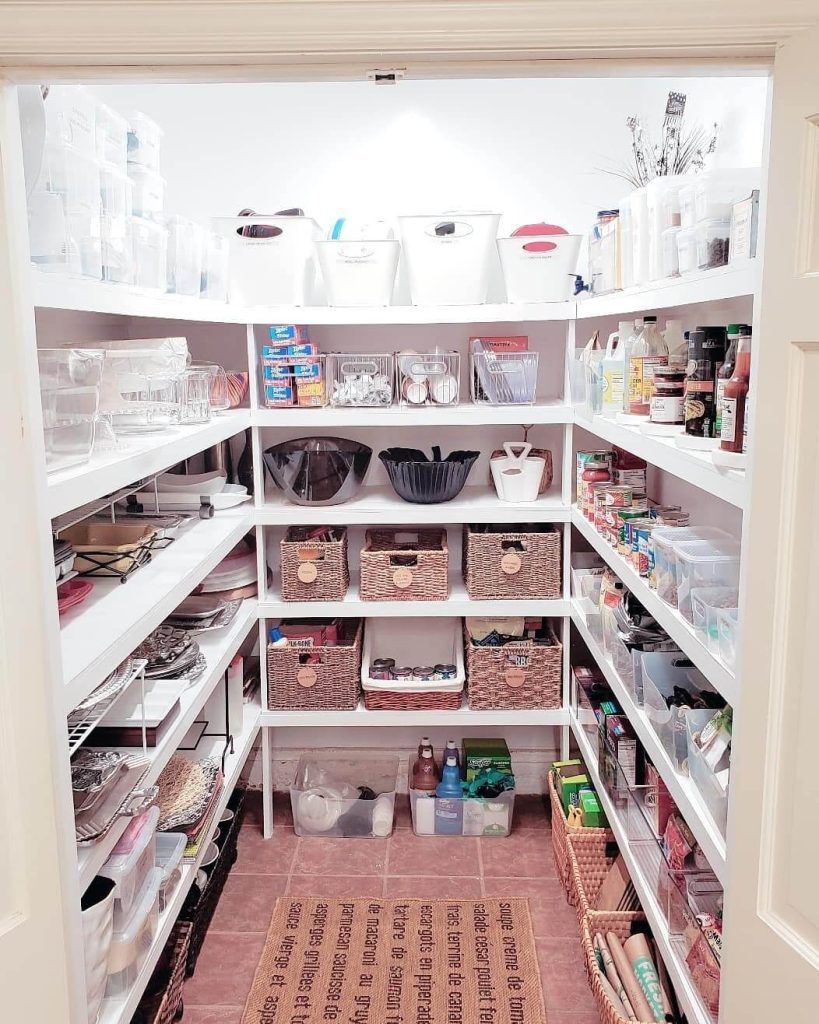
A highly efficient walk-in pantry doesn’t need to be massive—it just needs thoughtful zones. This layout uses woven baskets and labeled bins to group items by category: snacks, baking, paper goods, sauces, and more. By dedicating specific bins and baskets to each type of item, the space avoids clutter and confusion. Open shelves keep everything visible, while upper bins can be used for backstock. If your small pantry has depth, mimic this system to boost accessibility and maintain long-term organization.
9. Label Upper Cabinets to Eliminate Guesswork
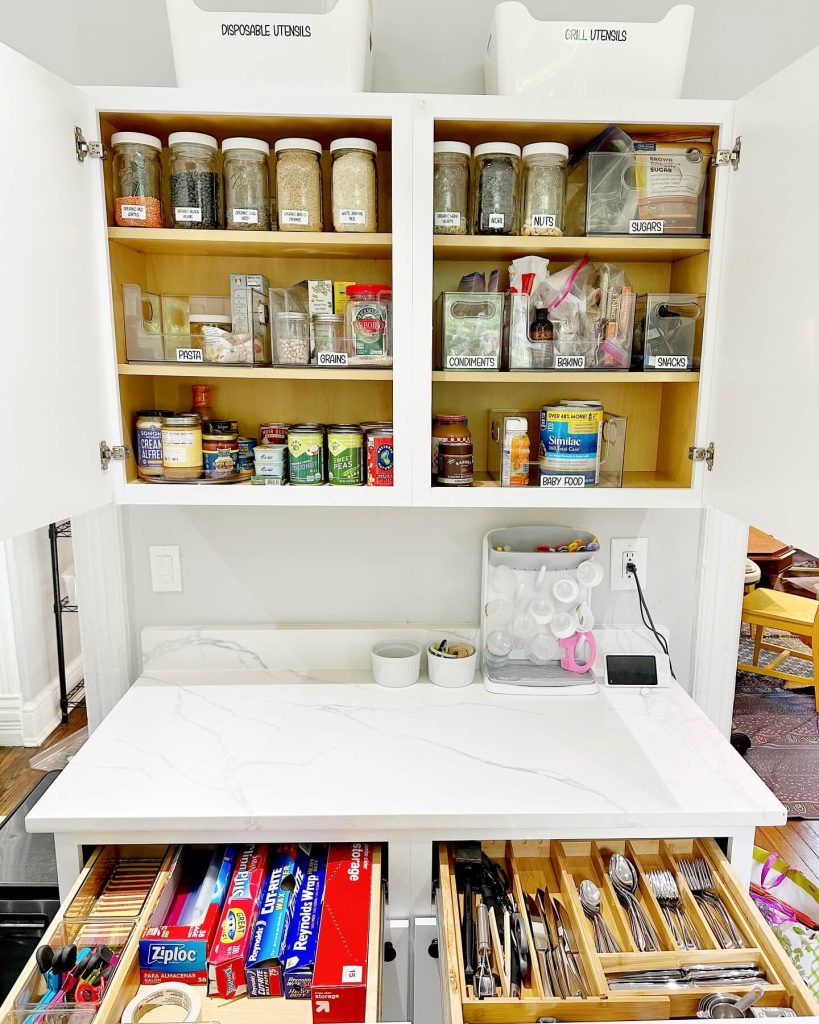
Using labeled bins inside upper cabinets is a smart hack for small kitchens. In this setup, every category has its place—from grains and condiments to baby food and snacks. Transparent jars line the top shelf, while labeled plastic bins on the bottom shelf keep loose items neat. The setup underneath, with a clean counter and drawer organizers, turns the area into a multipurpose command center. It’s a great example of using even the smallest cabinet spaces with maximum clarity and ease.
10. Add Pull-Out Drawers for Deep Pantry Cabinets
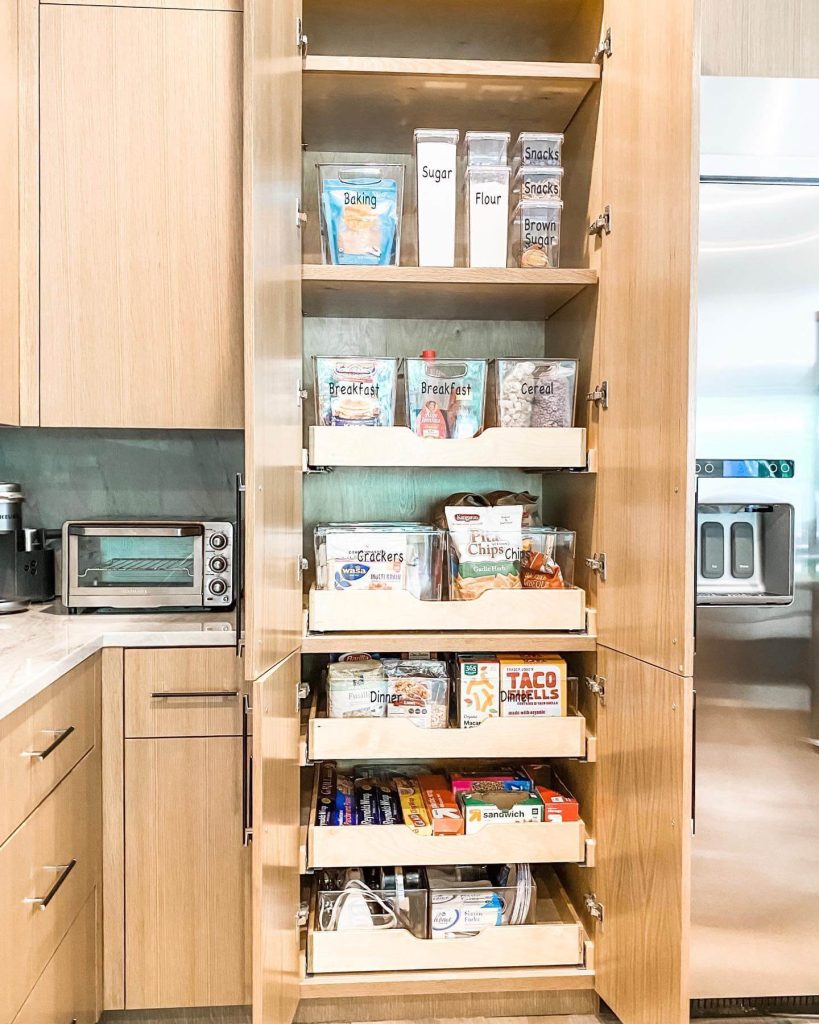
Pull-out drawers are a game-changer for deep pantry cabinets. This image features tiered drawer trays that slide out, making it easy to reach items at the back without creating chaos in the front. Each drawer is labeled and organized by meal category—breakfast, dinner, snacks, and baking. Clear bins and upright packaging further enhance visibility. If your pantry consists of a tall cabinet, installing pull-out trays can drastically improve usability while keeping everything beautifully sorted and within arm’s reach.
11. Design a Stylish Open Shelf Pantry Display
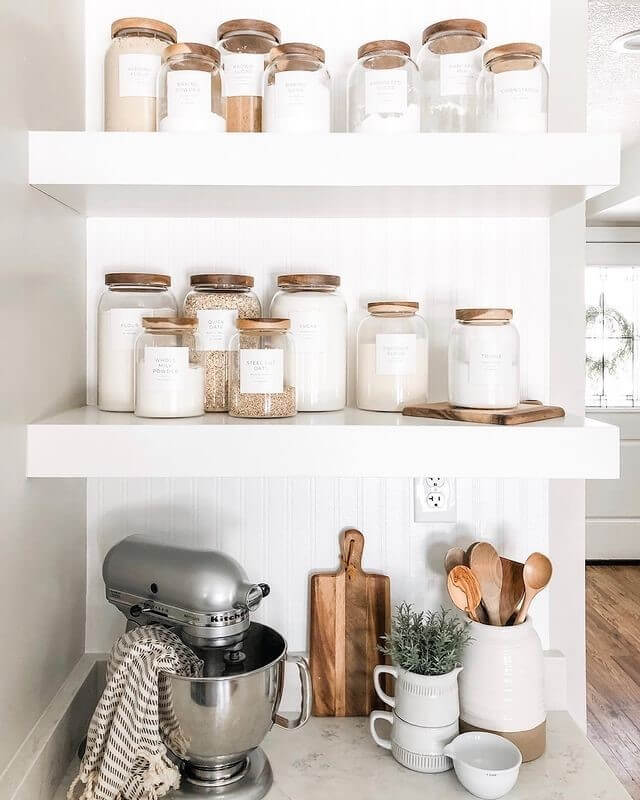
This minimalist setup proves that your pantry can double as kitchen décor. Clear glass jars with uniform wooden lids line floating white shelves, holding everyday essentials like flour, oats, and sugar. Positioned above a baking station, this arrangement is both beautiful and practical. It’s ideal for small kitchens with limited closed storage. Grouping similar items together and using matching containers gives the space a curated, cohesive aesthetic that blends seamlessly with modern or farmhouse interiors.
12. Use Woven Baskets for a Hidden-but-Organized Look

If you prefer to keep visual clutter at bay, woven baskets are a game-changer. This cabinet makes excellent use of vertical space with clear containers for pasta and grains on top, while snacks and packaged foods are sorted into labeled baskets below. This approach keeps loose items tucked away and easy to grab. It’s especially effective in smaller pantries or lower cabinets, where visual organization and quick access are equally important.
13. Extend Your Pantry into the Fridge for Seamless Storage
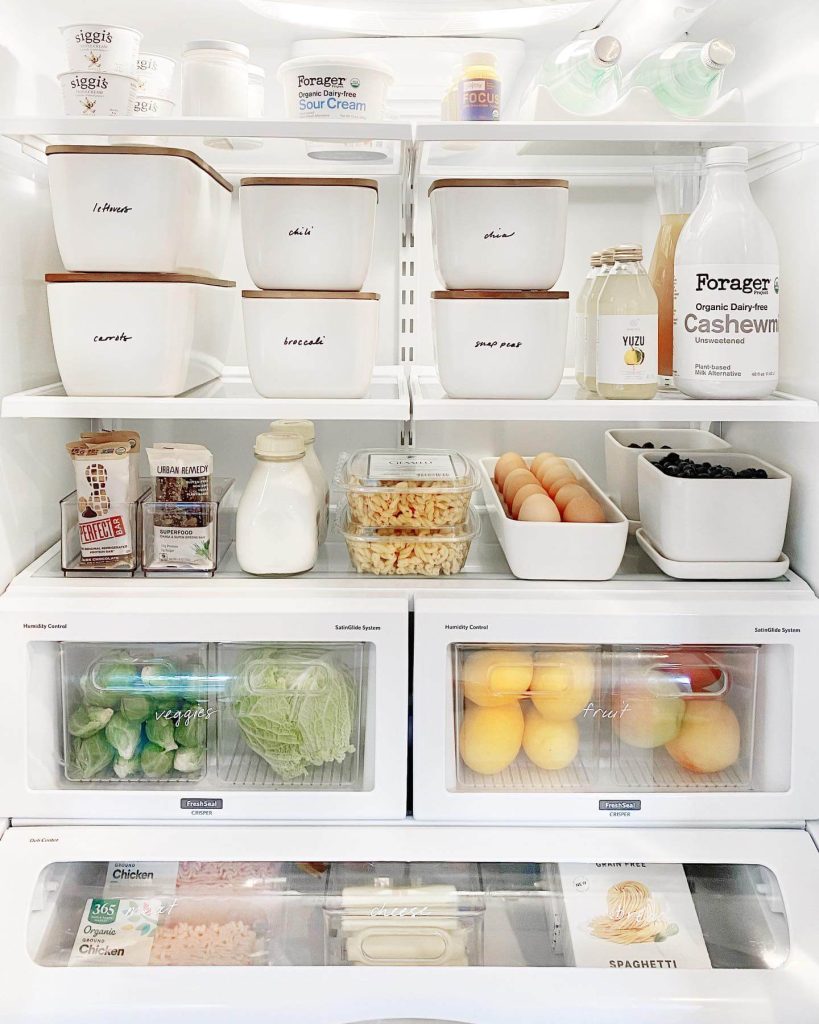
Smart pantry organization doesn’t have to stop at the pantry door. This fridge setup uses labeled containers that match pantry aesthetics, turning your refrigerator into an extension of your storage strategy. From dairy and eggs to prepped veggies and snacks, every item has its own container, making it easier to spot what you have and reduce food waste. Maintaining consistent labeling and container design across both pantry and fridge helps create a cohesive and organized kitchen experience.
14. Mix Hidden and Open Storage in Narrow Cabinets
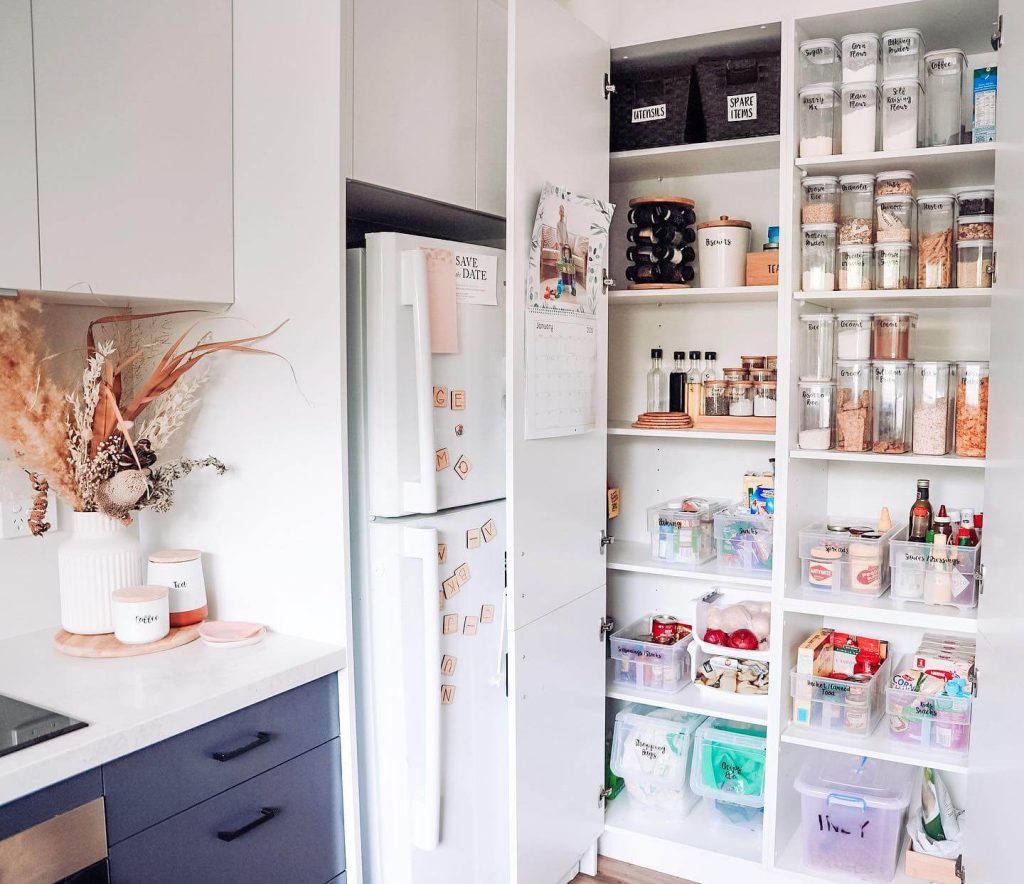
In this tall, narrow pantry, a combination of labeled bins, glass jars, and baskets creates a perfectly organized space. The upper shelves hold backstock and rarely used items, while the middle area stores daily essentials like grains, spices, and oils. Transparent bins at the bottom make it easy to spot onions, potatoes, and packaged goods. This setup is perfect for small pantries where every shelf needs to serve a different function—blending accessibility with smart storage.
15. Incorporate Tiered Risers for Spice and Jar Organization
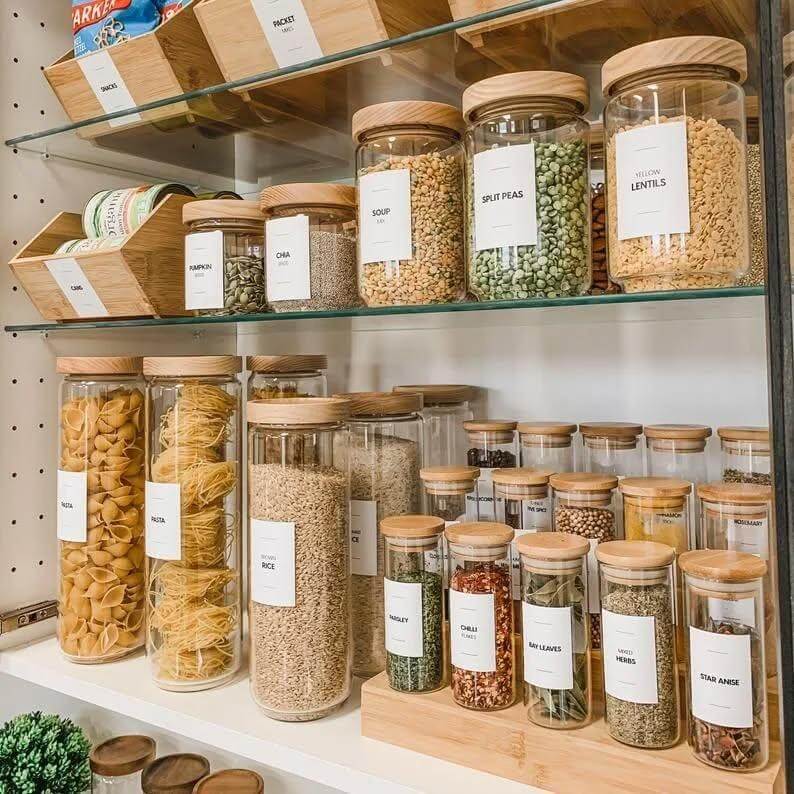
This shelf setup uses clear glass jars with bamboo lids arranged on multi-level risers to keep everything visible and tidy. The combination of vertical stacking and shallow shelves is ideal for small pantries, ensuring that nothing gets lost in the back. Labeling jars clearly makes it easy to grab what you need quickly, whether it’s pasta, spices, or legumes. Plus, using risers allows you to store more items without sacrificing visibility—a crucial feature in tight spaces.
16. Use Clear Bins for Quick Snack Sorting
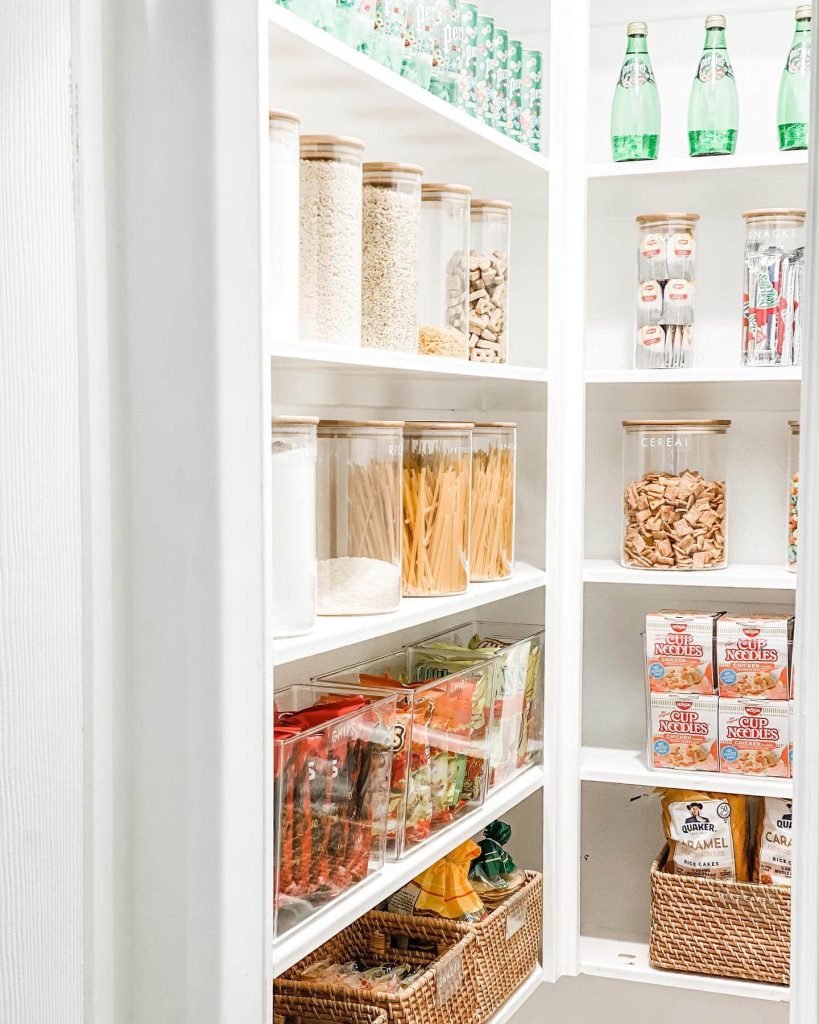
This pantry makes the most of clear acrylic bins for grab-and-go snacks, noodles, and treats. By grouping similar items together in transparent containers, it’s easy to take inventory and prevent overbuying. Vertical jars hold pasta, rice, and cereals with consistent labeling that ties the aesthetic together. This system is especially helpful in homes with kids or busy mornings, where quick access and visual clarity are key to staying organized.
17. Add Utility and Style with Open Shelving
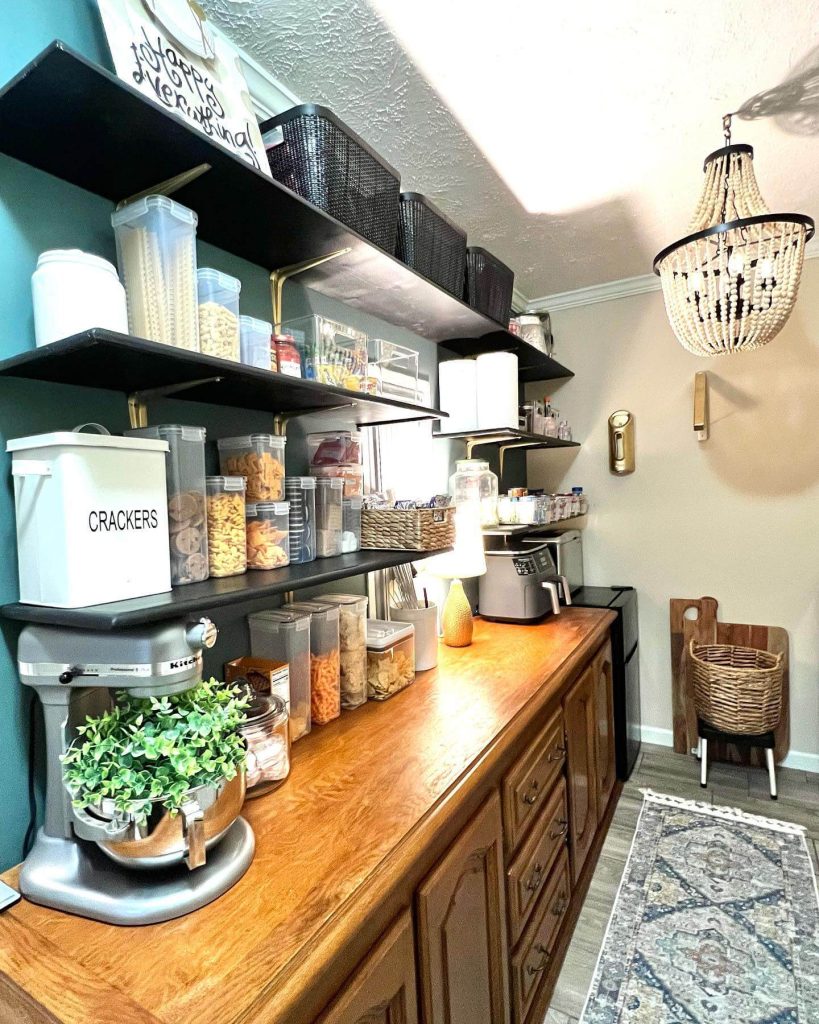
Here, floating black shelves paired with labeled canisters and baskets add both visual interest and functionality to a narrow pantry space. The placement of small appliances, snacks, and dry goods on open shelving creates a streamlined workflow for prepping meals or packing lunches. Stylish black storage bins on top offer hidden storage for lesser-used items. The addition of a lamp and decorative elements softens the space, proving that organization and design can go hand in hand.
18. Use a Lazy Susan for Compact Spice Organization
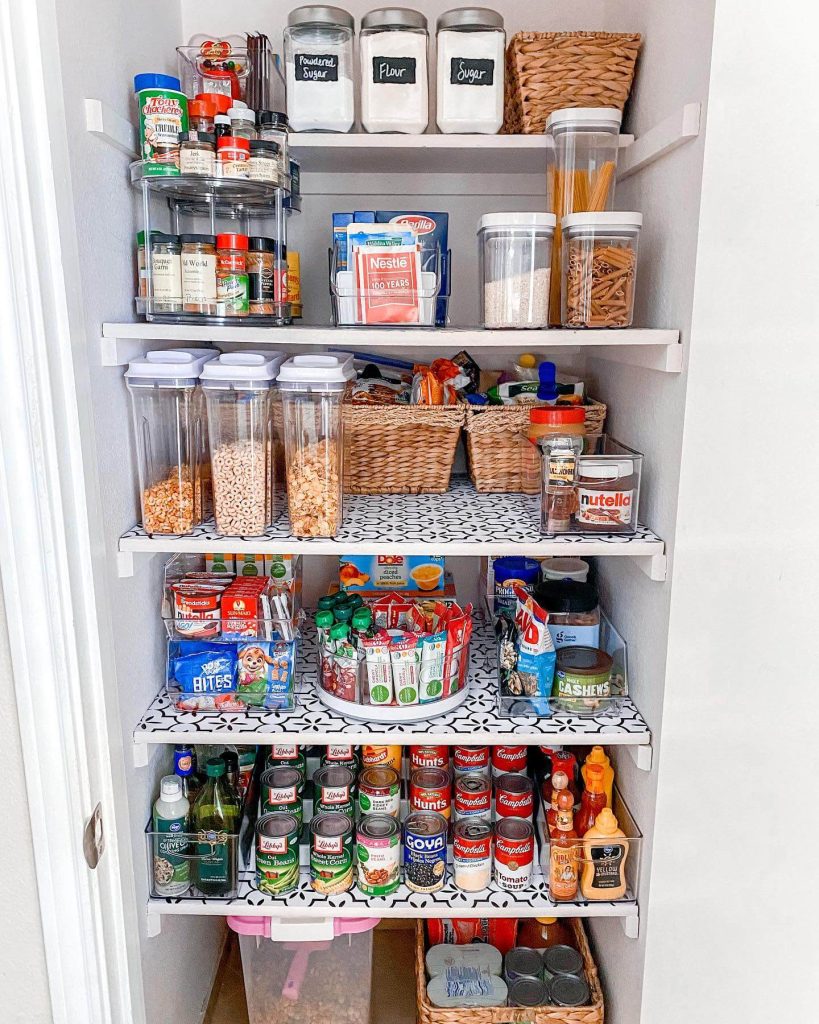
In this small but mighty pantry, the use of turntables (lazy Susans) and tiered shelves keeps everything within reach, even in tight spaces. Tall jars hold baking goods and cereals, while spices and condiments are grouped for visibility and efficiency. Using a mix of open and closed containers allows for a balance of neatness and accessibility. This setup works beautifully for renters or anyone working with a closet-sized pantry.
19. Designate Zones by Food Type for Consistent Order
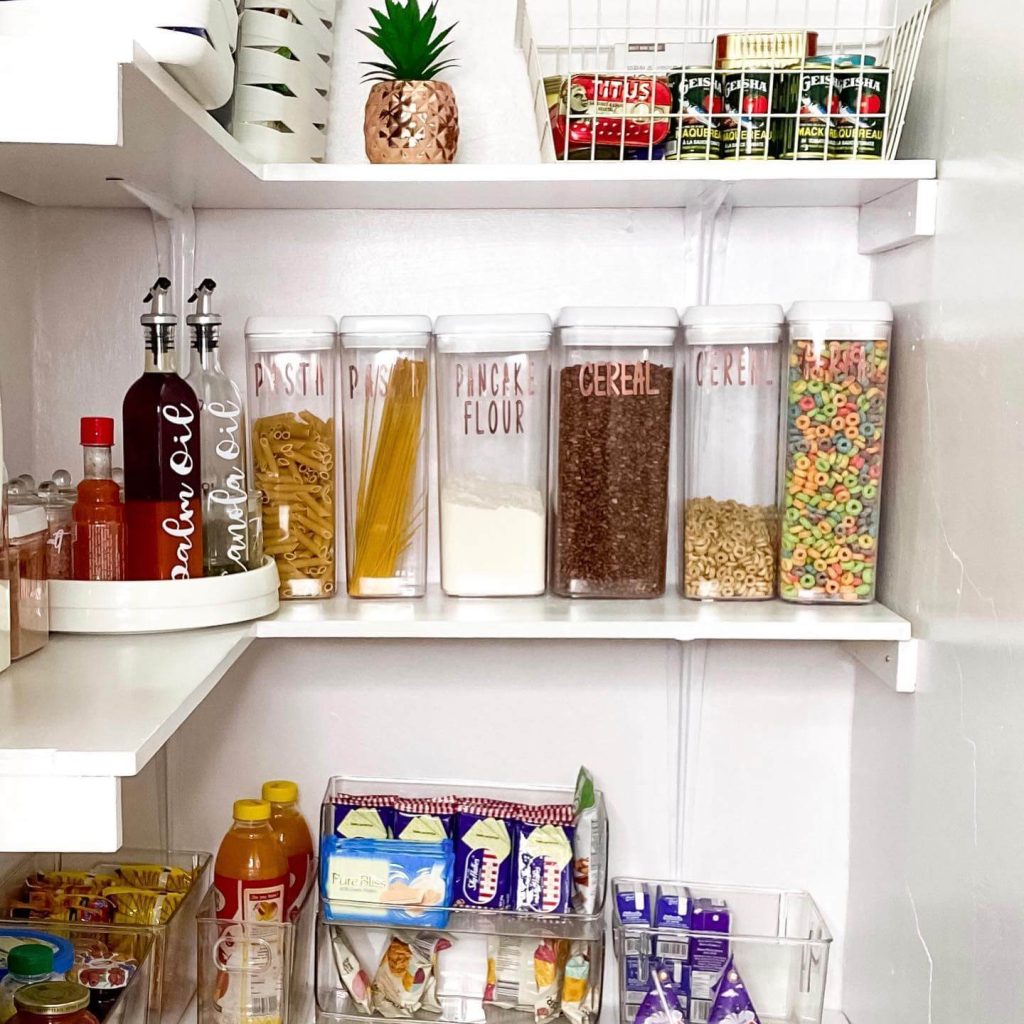
This setup nails food zoning—pasta, cereal, flour, and snacks all have clearly labeled spaces. Combining containers, bins, and baskets helps prevent cross-category clutter. A turntable holds oils and sauces, and stackable containers fit snugly on shallow shelves. This structure not only looks neat but also trains everyone in the household to put things back in their proper place. It’s a simple but effective technique for long-term pantry maintenance.
20. Mix Closed Containers and Wicker Baskets for Style and Function
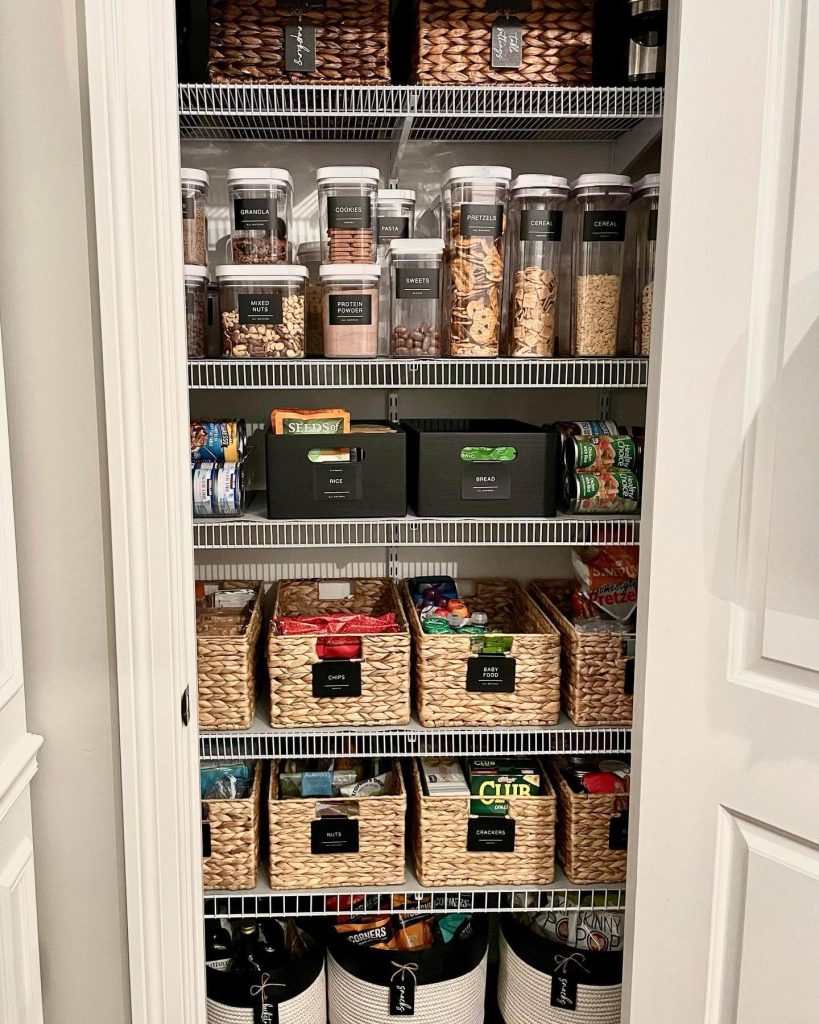
This beautifully organized pantry balances clear containers and woven baskets to perfection. The upper shelves feature airtight jars labeled for cookies, cereal, pasta, and more, while the lower levels house larger baskets for chips, baby food, and snacks. Each bin has a sleek black label, reinforcing consistency and helping everyone in the household locate items easily. The visual symmetry and practical layout show how even wire shelving can feel upscale with the right containers and a bit of planning.
21. Utilize Pull-Out Drawers for Deep Pantry Access
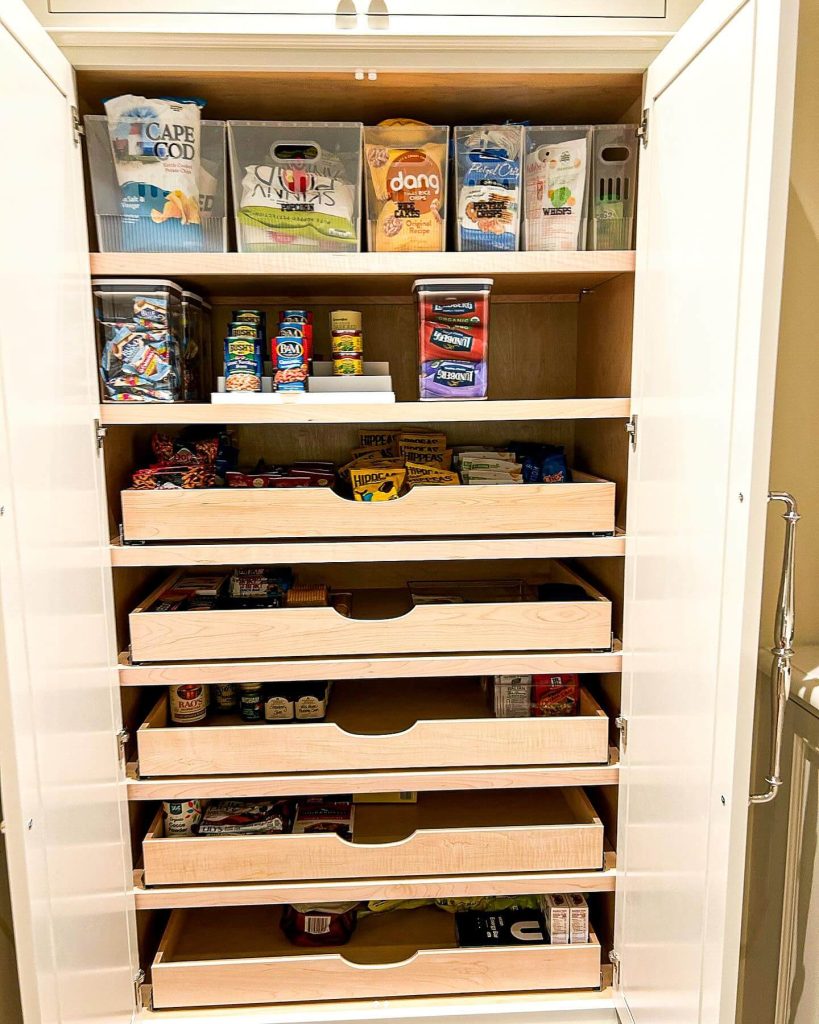
This beautifully crafted pantry uses pull-out drawers to eliminate the need to dig through cluttered shelves. Each drawer holds specific categories, from snacks and canned goods to baking supplies and miscellaneous items. The top shelf uses clear bins for chips and pantry staples, making it easy to scan what’s available. Pull-out drawers are perfect for maximizing deep cabinet space and ensuring that no items get lost at the back of the pantry.
22. Mix Materials for Texture and Functionality
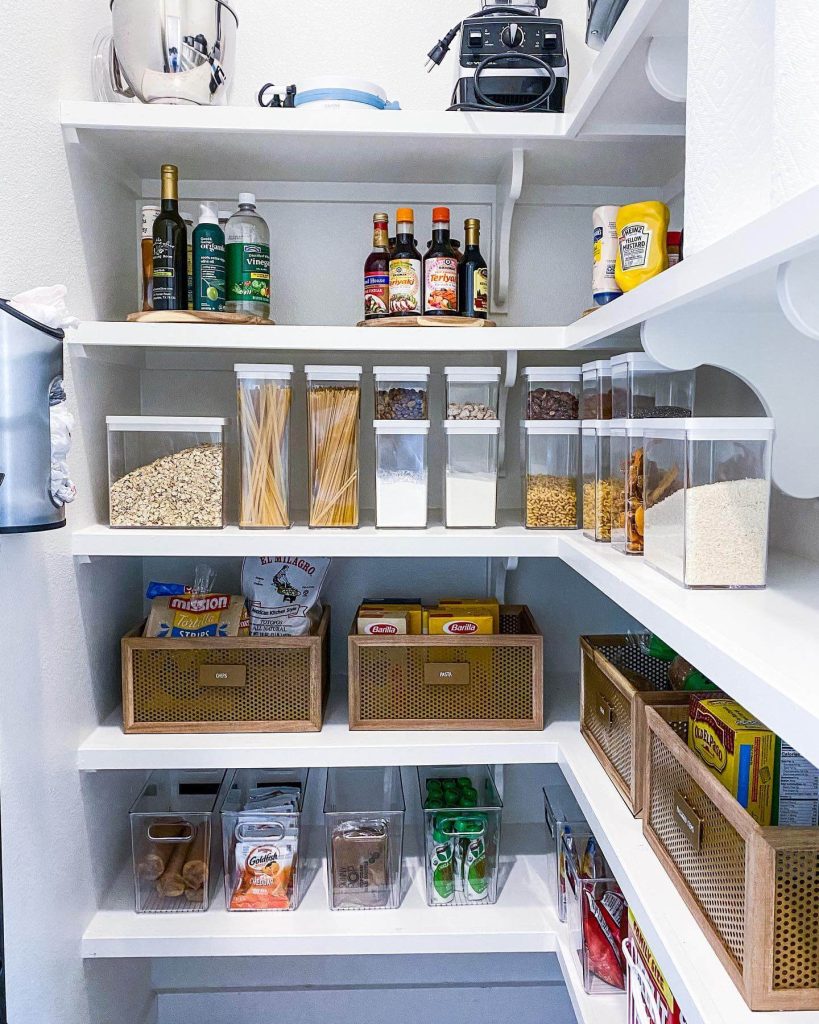
This pantry embraces a mix of rattan baskets, acrylic bins, and clear containers to create visual interest while keeping everything neatly compartmentalized. Open shelving allows for an airy layout, and categories like grains, pasta, and sauces are thoughtfully separated. This combination of materials makes the pantry both stylish and highly usable—perfect for those who want an organized space that also feels warm and lived-in.
23. Assign Categories with Chalkboard Labels
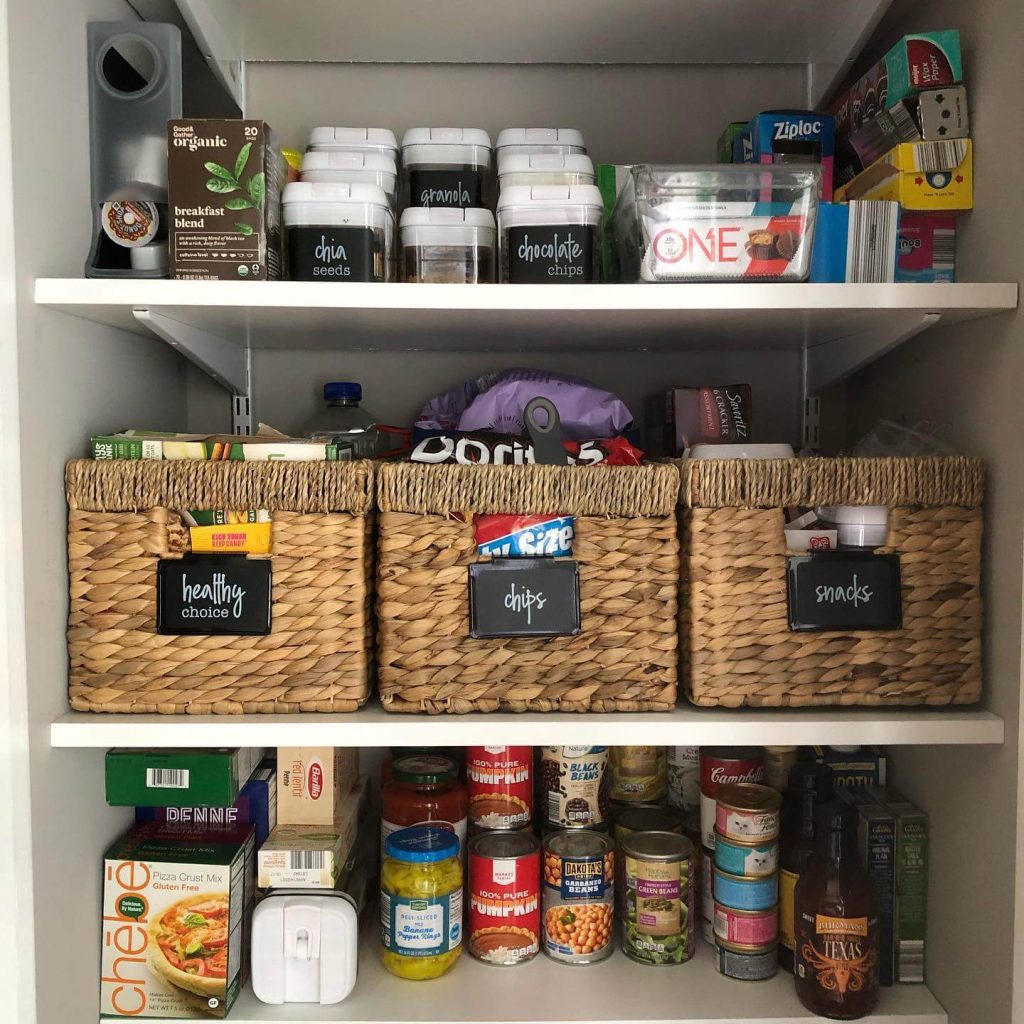
Wicker bins paired with chalkboard-style labels are a simple but effective way to categorize your pantry. This setup keeps chips, snacks, and healthier options easily accessible while maintaining a uniform look. Canned goods are stored in neat rows below, with dry goods and baking essentials stacked above. This system is perfect for small pantries where visual organization helps everyone stay on the same page when restocking or reaching for a snack.
24. Incorporate Built-In Shelves for Maximum Use of Doors
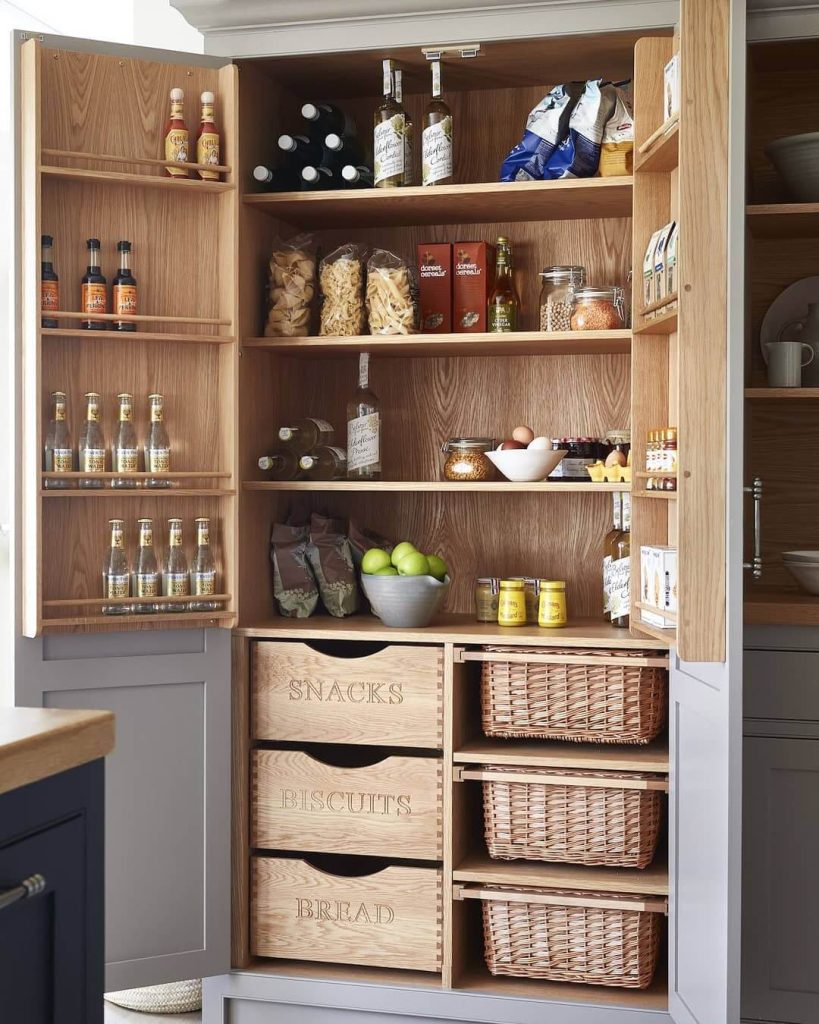
This cabinet pantry uses every inch of available space—including the interior of the doors. Bottles, sauces, and small jars are stored on door-mounted racks, freeing up central shelf space for dry goods, snacks, and bowls. Labeled wooden drawers make it easy to designate space for staples like snacks and bread, while wicker baskets offer hidden storage for loose items. It’s a brilliant design for tight spaces where functionality and access are key.
Small Pantry, Big Potential
Organizing a small pantry doesn’t mean compromising on functionality or style—it means getting creative with the space you have. With the right mix of clear containers, labeled bins, tiered storage, and drawer systems, even the tiniest pantry can be transformed into a powerhouse of efficiency and beauty.
The 24 ideas we’ve explored prove that small pantries can be just as functional (and stylish) as larger ones, when approached with intention and smart design. Whether you’re working with a single cabinet, a converted closet, or a compact walk-in, these organization strategies will help you cut clutter, find what you need faster, and enjoy your kitchen more every day.
So take the inspiration, adapt what fits your space, and remember—when it comes to pantry organization, it’s not about how much space you have, but how well you use it.


